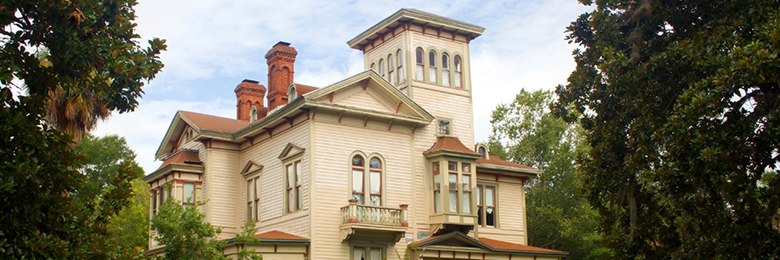Built to Last? Risks and Recommendations for Maintaining Older Homes

Owners of historic homes often become guardians of the meticulous craftmanship of bygone eras. But sometimes there are purposeful reasons why “they don’t make them like they used to.” While these residences may be less likely to succumb to perils that emerge in today’s cookie-cutter construction environment, they also bring a precise set of inherent risks. Fortunately, there are ways to modernize older properties while upholding historic integrity.
As a risk manager who specializes in historic home preservation, I’ve identified the top five threats that come with age:
- Water
- Fire
- Weather
- Structural movement
- Improper maintenance
Proactive ongoing attention can help stave off costly damage or, even more critical, the destruction of unique or architecturally significant features.
Water
No right-minded person would build a house today without insulation, nor would it be permitted by current codes. Although, while there are historical versions of insulation, such as filling the areas between floor joists or wall framing with bricks or a mortar-type material, most older houses were built without it. Many homeowners think of insulation solely as a temperature concern, but it is directly linked to a heightened risk of water damage.
When it comes to plumbing, the joints are the weakest and most common area of failure. With the added pressure and expansion created by freezing, joints can separate easily. What results can range from a small trickle to an outright burst with a full water flow. The good news is older homes often have high-quality craftsmanship even in the plumbing, as can be seen when comparing a copper pipe system to a modern PEX installation. Other top causes of water damage are toilets, tubs, and showers; so, they also require maintenance
What homeowners can do:
- When adding modern insulation, anticipate potential problems in addition to considering more obvious concerns such as comfort and climate efficiency. For example, are there pipes in the attic that are susceptible to freezing?
- Check shower and tub controls to make sure they are not loose, which could lead to failure behind the walls.
- Use toilet supply lines with metal fittings (nuts) instead of plastic.
- Regardless of the material, age or quality of installation, all houses can benefit from monitored water sensors that either shut off the water or provide early notification of a leak.
Fire
Older homes built of masonry and heavy timbers are better positioned to withstand a fire and burn slower. Ultimately, however, heavy timbers do burn, and masonry is damaged by the heat of the fire. Additionally, the water used to extinguish flames can break down the mortar and can cause structural collapse.
Electrical systems, followed by lightning strikes, are the most common causes of fires in older homes. Electricity became common in urban homes in the 1930s and typical everywhere after World War II. The earliest systems were knob-and-tube (1920-1950) and cloth-sheathed cables (1945-1978). Not only did these early systems have exposed wires or feature combustible materials, they also were not grounded. All of these factors can make older homes significant fire hazards. It wasn’t until the 1970s that properly insulated and grounded wiring became used as we know it today.
What homeowners can do:
- Replace any active wiring dating before the 1970s.
- All houses can benefit from a centrally-monitored fire alarm and sprinkler system.
Weather
A home’s exterior is the main line of defense against weather and catastrophic events. Starting at the top, it’s good to know the typical lifespan of popular roofing materials.
Wood shingles only last 15-20 years even though they are the most common historical roofing material, originating at settlement and remaining popular through the early 20th-century Colonial and Tudor Revival styles and beyond. By contrast, slate shingles, which gained popularity in the first quarter of the 20th century, can last 100 years. Metals, if re-coated, and clay tiles typically last 50 years. Many of today’s older homes have modern asphalt shingles that can last 20-50 years depending on quality.
The most common points of failure for roofing, and the most important to maintain, are flashing around chimneys or in valleys where the roof slopes. Another point of vulnerability is clogging of gutters or downspout systems that can’t direct water away from the structure.
Wall openings—namely, windows and doors—require ongoing maintenance. Repainting will protect the wood, and caulk around perimeters can help prevent moisture intrusion. Replacing original windows and doors is overly marketed as a necessity, but the originals can function well if properly maintained. For enhanced protection, there are many good options available for storm windows or hurricane shutters.
What homeowners can do:
- Visually check roofing and flashing from the ground often. Engage licensed professionals to inspect further if anything looks amiss.
- Clean gutters at least twice a year. Do it more frequently if there are overhanging trees nearby that drop leaves or pine needles on the roof.
- If water spots develop on interior ceilings or walls, engage a licensed roofing professional immediately to find and repair the cause of water intrusion.
Structural Movement
A baseline understanding of common age-related problems will help homeowners prioritize repairs appropriately. For example, typical characteristics of older homes include sloping, creaky floors and slanted walls. When these issues are present, it’s important to know whether the home has been in that condition for decades (and therefore stable), or if it is actively moving.
There are some general ways to gauge the nature of cracks, which can offer an initial sense of a likely issue. Simply stated, a new crack in a masonry or plaster wall will have sharp edges, while an older crack will be smoother with less jagged edges. Similarly, cracks that follow the mortar joints as the path of least resistance typically reflect less severe structural movement than those that go through the brick or stone.
What homeowners can do:
- Structural issues can be serious. Always consult professionals who understand historic buildings.
Improper Maintenance
When it comes to making repairs, it can do more damage than good if the materials used are incompatible with the historic materials. The most common and avoidable problem I’ve observed in this regard is with brick walls. Historic bricks and mortar were made using softer materials that don’t contain cement (cement wasn’t commonly used until the early 20th century). If you repoint an old brick wall with a modern mortar mix, which contains cement, it will result in spauling; the face of the brick (fire skin) falls off. Certainly not a desired result. Also, mortar with a high cement content is often greyer in color, which won’t match the older mortar well, particularly in houses of the late 19th century that were built with red-tinted mortar.
What homeowners can do:
- Even with the best mitigation efforts, unexpected problems and damage can occur. Historic home specialists can help devise a plan specific to a home’s unique needs and circumstances.
- In the event of sudden or accidental damage, it is important to have the right insurance coverage, valuation and claims expertise for historic structures. Most homeowners’ policies do not provide for replacement of “like kind and quality.” Of those that do, accurate valuation and expertise in historic buildings are critical to adequately repair or replace the damage.
Final Thoughts
There is an oceanfront home built in 1922 in Southampton, New York that survived the Great New England Hurricane of 1938 and a small fire years later. It has been maintained and upgraded over the years in ways that retained the original architectural character while also making it safer. With new roofing, modern mechanical systems, and a new impact-rated window sash custom made to match the originals, this home has the best of historic character combined with modern improvements. This example illustrates the hope for all who choose to reside in a piece of history; when the owners’ attention to detail extends to the protection of a property, it can be enjoyed for many years to come.
~~~
 Becca Hunt, National Valuation Manager, Equine & Historic Home Risk Manager, AIG Private Client Group
Becca Hunt, National Valuation Manager, Equine & Historic Home Risk Manager, AIG Private Client Group

Becca is the National Valuation Manager within AIG Private Client Group’s Risk Management Services department. She has been with AIG Private Client Group since 2005. In 2006, she served as Training Manager and established the first formalized training program for Risk Management Services. Becca joined the Platinum Account team in 2007 where she serves as the risk manager for many of the largest and most complex accounts, providing detailed valuation calculations, customized loss prevention solutions and coordinating complimentary services. In 2016, she took on the additional role of managing inspections for AIG Private Client Group’s multinational program. She also contributes her expertise in Equine and Historic Home risk management.
Prior to joining AIG, Becca had her own architectural consulting business and completed insurance inspections exclusively for AIG from 2002 to 2005. From 1999 to 2002, she was an appraiser and valuable articles specialist for the Chubb Group of Insurance Companies’ Philadelphia office. Prior to getting into insurance, Becca was a historic preservation specialist at architectural firms in the greater Philadelphia area for seven years.